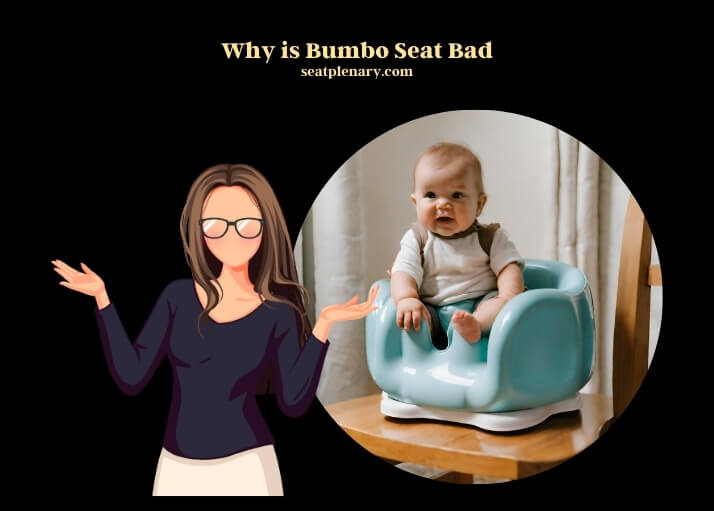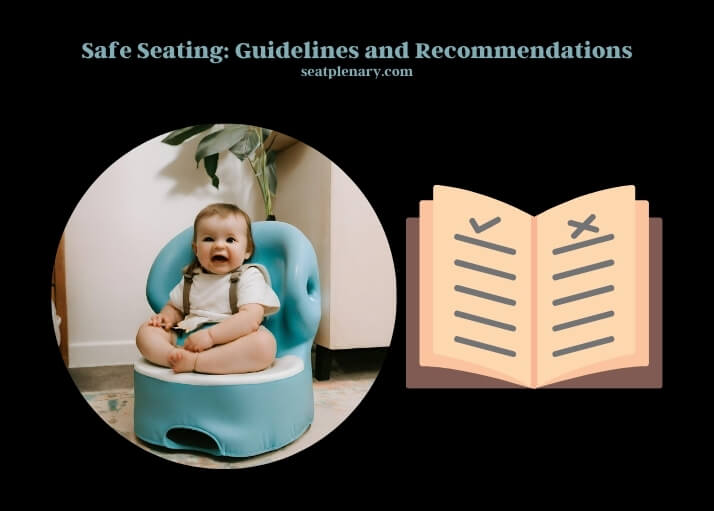Bumbo seats are often criticized for potentially hindering infants’ natural development and posing safety risks. These concerns primarily stem from the seat’s design, which can limit movement and encourage poor posture.
The Bumbo seat, a popular choice among parents for its convenience, has faced scrutiny from pediatricians and child development experts. Designed to seat infants who cannot sit up on their own, the Bumbo seat may impede the natural development process. Infants learn to sit, crawl, and walk through trial and error, and by exploring their environment.
The Bumbo seat restricts this exploration and the opportunity to develop the necessary muscle strength and coordination on their own. Moreover, the seat positions infants in an unnatural posture that can affect their spinal development and hip alignment.

Safety is another significant concern. There have been reports of infants tipping over or falling out of the seat, especially when placed on elevated surfaces. Despite warnings and product recalls, accidents continue to occur, leading to questions about the seat’s overall safety.
Reliance on the Bumbo seat for sitting can delay milestones such as independent sitting and crawling, as it substitutes the natural learning process with artificial support. Parents and caregivers are encouraged to consider these factors and opt for more developmentally appropriate seating solutions that allow infants to move freely and develop at their own pace.
Rethinking Bumbo Seat Safety
The Bumbo seat, a popular infant seating solution, has faced scrutiny over its safety. Designed to support infants who can’t sit up on their own, these seats have been linked to several risks. First, there’s the danger of falls. Infants can wiggle and tip over, especially if the seat is placed on an elevated surface.
This risk is compounded by the fact that the design does not encourage proper posture. Infants often slump or lean forward, which can lead to developmental delays. Sitting in a Bumbo seat for prolonged periods may hinder the natural progression of motor skills as it limits the range of movement necessary for developing core strength and coordination.
Exploring Alternatives for Infant Seating
Given the concerns surrounding Bumbo seats, parents and caregivers might consider safer alternatives. High chairs, when used with appropriate safety straps and under supervision, offer a secure dining option. For playtime, floor time is invaluable, promoting motor skills and physical development without constraining movement.
Parent lap seating fosters bonding and ensures safety, while structured carriers support the infant’s posture and allow for mobility. Each alternative serves a purpose, from feeding to bonding, and supports development without the risks associated with Bumbo seats.
The Developmental Debate: Bumbo Seats and Growth
The impact of Bumbo seats on infant development is a contentious topic. Critics argue that these seats may negatively affect hip development and spine alignment, crucial aspects of physical growth. The constrained position can limit natural movements that are essential for strengthening the body and developing motor skills.
Infants need the freedom to move, reach, and explore to hit developmental milestones in a timely manner. Encouraging activities that promote natural progression of sitting and movement skills is vital for healthy development.
Consumer Insights on Bumbo Seat Usage
Feedback from parents and safety reports highlight mixed experiences with Bumbo seats. While some find them convenient for short periods, others report accidents and express concerns over safety. The history of recalls and warnings about the seats underscores the need for caution. This mixed feedback suggests that while the Bumbo seat might offer temporary convenience, it may not be the best choice for every family or situation.
Safe Seating: Guidelines and Recommendations
For those who choose to use infant seating solutions, following safety guidelines is paramount. This includes adhering to age and weight recommendations, ensuring constant supervision, and selecting seats that support the infant’s developmental stage. Proper use of seating solutions can mitigate risks and support healthy development.

Comparison of Infant Seating Solutions
| Seating Solution | Age Range | Benefits | Potential Risks |
| Bumbo Seat | 3-12 months | Supports sitting | Risk of falls, developmental delays |
| High Chair | 6-36 months | Mealtime seating | Requires supervision, can tip over |
| Floor Time | 0+ months | Promotes motor skills | Needs constant supervision |
| Parent Lap | 0+ months | Bonding, safety | Fatigue for parent |
Developmental Milestones and Seating Options
| Age Milestone | Recommended Seating | Reason |
| 0-3 months | Parent’s arms/Floor time | Promotes bonding and early motor skills |
| 3-6 months | Structured carriers, supervised floor time | Encourages head control and sitting practice |
| 6+ months | High chairs, supervised Bumbo seat use | Supports sitting and mealtime interaction |
FAQs
Can Bumbo Seats Affect Spinal Development?
Bumbo seats, designed to support infants before they can sit independently, have sparked concerns regarding spinal development. The seat’s design, which holds the child in an upright position, may not provide the necessary support for the developing spine. Infants require a variety of movements to strengthen their back and neck muscles adequately.
Relying on a Bumbo seat for prolonged periods can limit these movements, potentially leading to an over-reliance on the seat’s support rather than developing their own muscle strength. This limitation can delay milestones related to sitting, crawling, and walking, as infants miss out on practicing these essential movements on their own.
Do Bumbo Seats Limit Physical Activity?
The use of Bumbo seats may inadvertently restrict an infant’s physical activity. By confining an infant to a seated position, the opportunity for them to engage in tummy time, roll over, and explore their environment is reduced. These activities are crucial for developing motor skills, muscle strength, and coordination.
Physical activity in infancy lays the groundwork for healthy growth and development, including cognitive and sensory-motor skills. Limiting this activity not only hampers physical development but may also affect the infant’s curiosity and interaction with their surroundings, which are vital for overall development.
Are There Risks of Dependency on Bumbo Seats?
Dependency on Bumbo seats for sitting can emerge as a significant concern. Infants might become accustomed to the support provided by the seat, potentially delaying their ability to sit independently.
This dependency can hinder the natural progression of developing balance and core strength, as infants are not given enough opportunity to practice these skills without assistance. Encouraging natural development stages through floor play and supervised sitting allows infants to build the necessary muscle strength and coordination to sit, crawl, and walk independently.
How Do Bumbo Seats Impact Interaction and Engagement?
Seating an infant in a Bumbo seat may also impact their ability to interact and engage with their environment. Positioned at a lower level and restricted in movement, infants might find it challenging to reach for toys, make eye contact, and interact with caregivers and peers.
This limited interaction can affect social and cognitive development, as infants learn through play and engagement with their environment. Encouraging floor time and other activities that promote a full range of motion can enhance an infant’s exploration and learning opportunities.
Is There a Concern Over False Milestones with Bumbo Seats?
Bumbo seats can create a misconception of developmental milestones, such as sitting. While it may appear that an infant can sit independently when placed in a Bumbo seat, this does not necessarily indicate that they have achieved the milestone naturally. True sitting involves a complex coordination of muscles and balance that infants develop over time.
The premature use of Bumbo seats might lead parents to overlook the importance of natural progression and the activities that support it, potentially delaying genuine developmental achievements.
What Are the Long-Term Effects of Using Bumbo Seats?
Considering the long-term effects of using Bumbo seats, there is a concern that extended use could lead to delayed development in sitting, crawling, and walking. The lack of opportunity for infants to move freely and explore their environment can limit their physical, cognitive, and social development.
While the immediate convenience of a Bumbo seat might be appealing, it’s essential to weigh these potential long-term impacts. Encouraging a variety of positions and activities that promote natural development stages is crucial for healthy growth and avoiding delays in developmental milestones.
In summary, while Bumbo seats offer a convenient solution for supporting infants not yet able to sit unassisted, they come with notable safety and developmental concerns. Alternatives like high chairs and structured carriers, alongside supervised floor time, provide safer and more beneficial options for infant development. Consumer feedback and safety reports further emphasize the need for caution and adherence to guidelines when using any infant seating solution.
